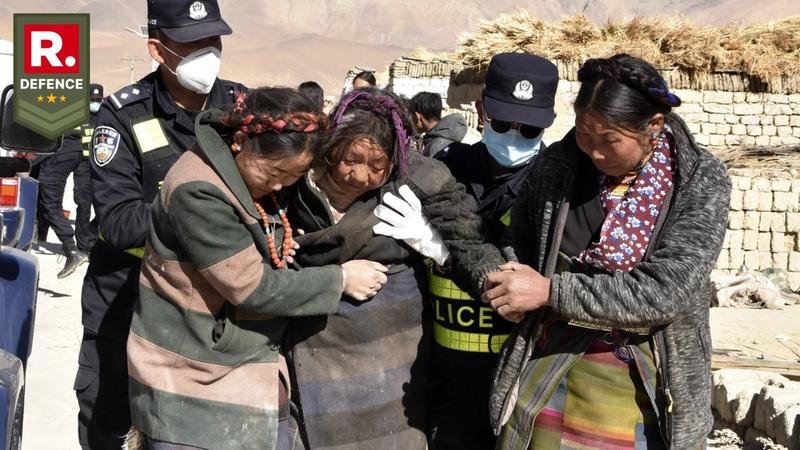Published 22:43 IST, January 8th 2025
China Exploits Tragedy to Push “Xizang” Rebranding of Tibet as Earthquake Kills 126
As rescue operations involving 1,500 workers unfold, Beijing’s response has sparked criticism.

Dingri County, Tibet – A catastrophic earthquake with a magnitude of 7.1 struck Dingri County in Tibet, killing over 126 people and leaving hundreds injured or displaced. The disaster, which rippled through neighbouring Nepal and parts of India, has brought to light China's continued exploitation of Tibetan tragedies to advance its geopolitical and colonial agenda. This includes replacing the internationally recognized term "Tibet" with "Xizang" in media coverage—a calculated effort to erase Tibetan identity.
Even as rescue operations involving 1,500 emergency workers are underway, Beijing's messaging around the earthquake has drawn sharp criticism. Chinese press releases consistently referred to the Tibet Autonomous Region (TAR) as "Xizang," the Chinese transliteration of "Tsang" used since the Qing dynasty. This move aligns with a December 2023 directive that mandated the use of "Xizang" in English to supplant the cultural and historical identity associated with "Tibet." By doing so, China seeks to normalize its colonial hold over the region and diminish global awareness of Tibet's unique heritage and its struggle for autonomy.
India’s Media: Unwitting Allies in China’s Information War?
China’s influence over international narratives is alarmingly evident in the Indian media’s adoption of the term "Xizang." This linguistic capitulation reflects a failure to recognize the stakes in the broader battle of information warfare. By using Beijing’s terminology, Indian media unwittingly aids China’s effort to delegitimize Tibet’s identity and, by extension, weaken India’s own geopolitical position.
This should serve as a wake-up call for India and the global community. China’s colonial ambitions are not confined to Tibet; they extend to disputed territories like Arunachal Pradesh and Ladakh. Controlling the narrative is the first step in controlling the territory, and Beijing’s mastery of this tactic is evident.
China’s Dam Projects a Cause of Seismic Instability
The earthquake has also reignited concerns about the ecological and geological impact of China's extensive dam-building projects in the region. Central to these concerns is the newly approved mega-dam on the Yarlung Tsangpo River, one of the world’s most hydropower-rich but ecologically sensitive regions. This massive project, with an estimated cost of $137 billion, poses significant risks to local ecosystems and downstream nations like India and Bangladesh.

Local Tibetan authorities and activists have attributed the earthquake’s devastating impact to China’s hydropower initiatives. The construction of large dams in seismic zones, such as the Tibetan Plateau, is known to exacerbate geological instability. The region already sits on a major fault line, and altering water flows and pressures through massive infrastructure projects can trigger or amplify natural disasters like earthquakes and landslides.
Environmental Concerns and Regional Impacts
The Yarlung Tsangpo River, which flows into the Brahmaputra, sustains millions of lives downstream. The ongoing dam projects threaten not only Tibetan ecosystems but also the livelihoods of communities in India and Bangladesh. Changes to water flow can disrupt agriculture, fisheries, and biodiversity. Furthermore, the fragile ecology of Tibet’s canyons, home to unique flora and fauna, is at risk of irreparable damage.
Critics argue that China’s dam-building frenzy prioritizes economic and political ambitions over environmental safety and disaster preparedness. By creating massive reservoirs in an earthquake-prone region, Beijing is playing with fire, risking a chain reaction of geological catastrophes.
Tibetan Voices of Resistance
Local Tibetan authorities and residents have openly criticized Beijing’s approach, accusing it of prioritizing its hydropower ambitions over the safety and well-being of Tibet’s people and ecosystems. These voices highlight the stark contrast between China’s narrative of development and the ground reality of displacement, environmental degradation, and cultural erasure.

Tibetans have long resisted Beijing’s attempts to transform their homeland into a resource hub for Chinese ambitions. The renaming of Tibet to "Xizang" is seen as part of this larger strategy to subsume Tibetan identity under the guise of modernization and integration. Many Tibetans view the ongoing militarization and industrialization of their land as a continuation of colonial policies that began with China’s annexation of Tibet in 1950.
The earthquake’s epicentre near the disputed borders of India and Nepal underscores the broader geopolitical stakes in the region. China’s aggressive infrastructure projects and territorial claims—such as those on Arunachal Pradesh (administered by India) and areas near the Chumbi Valley (recognized as Bhutanese territory)—have escalated tensions with its neighbours. The militarization of border areas and the exploitation of natural resources in Tibet are central to Beijing’s strategy to consolidate control over the region.
International Responsibility and the Path Forward. For now, China continues to push its colonial narrative under the guise of humanitarian and development efforts.
Updated 22:43 IST, January 8th 2025




